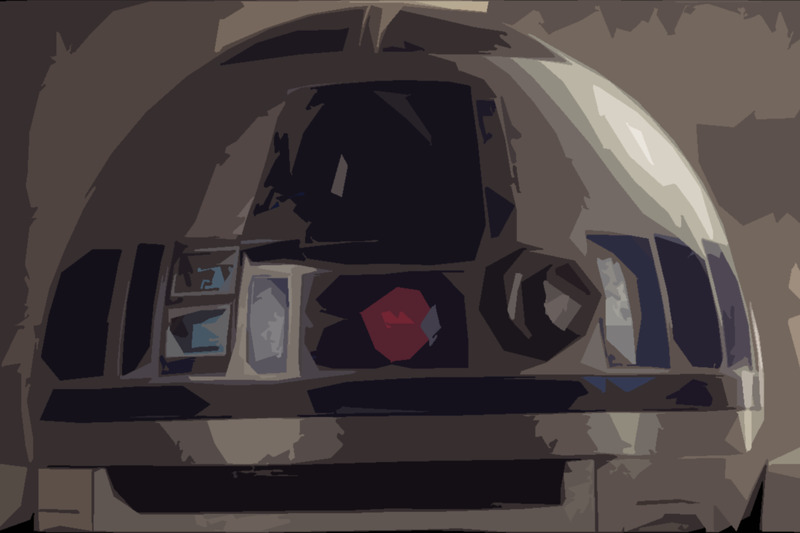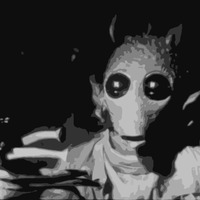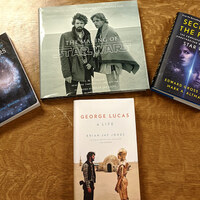Exhibit Contents
- Starkiller to Skywalker
- Other Changes
Other Changes
In addition to the various changes mentioned in other parts of the exhibit, below are additional differences between the shooting script and the final film:
- The title crawl is somewhat longer in the shooting script (117 words compared to 83 words in the final film) and has a more general description of the conflict between the Empire and the Rebel Alliance. While it does mention the Empire building a new battle station capable of destroying an entire planet (without giving a name to this station), the script’s title craw makes no mention of the stolen Death Star plans or Leia’s efforts to escape with them. After Lucas screened the film to several of his filmmaking friends in February 1977, Brian De Palma and Jay Cocks felt that the title crawl ought to explain what happens right before the start of the movie. They helped Lucas rewrite the title crawl to focus more on Leia fleeing with the Death Star plans.[1] Lucas continued to massage the title crawl throughout post-production, and it was one of the last elements of the film to be finalized. ILM shot the final title crawl in early May 1977, only about three weeks before the film was released.[2]
- The moment where C-3PO is covered in wires and says, “Help! I think I’m melting! This is all your fault!” to R2-D2 is placed in the shooting script at the start of the film as the droids escape from the stormtroopers aboard the Tantive IV. In the final film, this shot is moved to the Millennium Falcon after the heroes escape from the Death Star.
- The scene in Obi-Wan’s home is arranged differently in the script compared to the final film. As written, Obi-Wan and Luke watch hologram Leia ask for help, then Obi-Wan and Luke talk about the Force and Luke’s father, Obi-Wan gives his lightsaber to Luke, and then Obi-Wan decides to go to Alderaan. The scene was even shot this way. However, upon viewing, Obi-Wan and Luke come across as heartless first hearing Leia’s plea but chat a bit before deciding to help. Lucas and his editors moved the Force and father exposition dialogue to the start of the scene and inserted a shot of R2-D2 beeping to remind Luke and Obi-Wan to watch the message.[3] Thus, in the final film, Obi-Wan immediately decides to help upon hearing the message.
- The script explicitly describes Darth Vader as the “Dark Lord of the Sith,” and Imperial Officer Tagge says of Vader, “This Sith Lord sent by the Emperor will be our undoing.” This line was cut from the film, and neither Vader nor the Emperor are ever given the title of “Dark Lord of the Sith” in any of the original trilogy films. Obi-Wan Kenobi merely says that Vader is a former Jedi seduced by the dark side. It wasn’t until the prequel trilogy that Star Wars films explicitly used the term “Sith,” which canonically identified Vader and the Emperor as Sith Lords.
- In the script, Darth Vader summons a cup to his hands while stating that the Death Star is not as powerful as the force. In the film, he merely says the line. The ability to move objects with the force is not shown in the films until Luke pulls his lightsaber to his hand in The Empire Strikes Back.
- The script mentions an alien girl having her arms around Han Solo when Luke and Obi-Wan meet him at the cantina. Han then sends her away. When the scene was shot, Han instead was with a human woman portrayed by Jenny Cresswell. Her brief appearance with Han was cut during editing. However, she can be seen in the cantina crowd in the final film, and the character, named Jenny after the actress, appears in the canon 2015 novelization of A New Hope, The Princess, the Scoundrel, and the Farm Boy.
- In both the script and the film, Luke gapes at Leia for a moment when he finally meets her in person. In the script though, Luke has an additional line, “You’re even ... more beautiful ... than I ...” which was cut from the final film.
- Leia kisses Luke on the lips before swinging across the Death Star chasm in the script, whereas in the film she kisses him on the cheek. Additionally, Mark Hamill said this in a 2005 interview:
“I know for a fact that Marcia Lucas was responsible for convincing [George Lucas] to keep that little "kiss for luck" before Carrie [Fisher] and I swing across the chasm in the first film: ‘Oh, I don't like it, people laugh in the previews,’ and she said, ‘George, they're laughing because it's so sweet and unexpected’--and her influence was such that if she wanted to keep it, it was in.”
- Mark Hamill[4]
- In the Death Star battle, Luke’s X-Wing squadron, Red Squadron in the final film, is named Blue Squadron in the script. Additionally, the Y-Wing squadron called Gold Squadron in the final film is named Red Squadron by the script. This change happened entirely for technical reasons: the ship models were shot against bluescreen, and if they had used blue paint on the ships instead of red paint, parts of the ships would have disappeared because of the way bluescreen effects work. ILM thus painted those ships red and named it Red Squadron, and what was known as Red Squadron in the script were painted gold and named Gold Squadron. Thus, Luke’s callsign changed from Blue Five to Red Five.[5] Eventually though, Blue Squadron made a canon appearance in Rogue One nearly forty years later.
- After destroying the Death Star and returning to the rebel base, Luke does not acknowledge that R2-D2 was damaged during the battle in the script. In the film, Luke directly notices the damage to R2-D2 as he is lifted out of the X-Wing, exclaiming “Oh no.” After C-3PO expresses concern and offers his parts to help repair him (which is scripted), Luke assures C-3PO “He’ll be alright,” which was not in the script.
[1] J. W. Rinzler, The Making of Star Wars (New York: Del Rey Books, 2007), 255-258.
[2] Rinzler, The Making of Star Wars, 285-286.
[3] Rinzler, The Making of Star Wars, 238.
[4] “A Funny Thing Happened on the Way to Toshi's Station: FFC Interviews Mark Hamill,” Film Freak Central, March 20, 2005, https://web.archive.org/web/20220105205322/https://www.filmfreakcentral.net/ffc/2005/03/mark-hamill-interview.html.
[3] See Lucas' handwritten notes on the script in Rinzler, The Making of Star Wars, 237-238.


